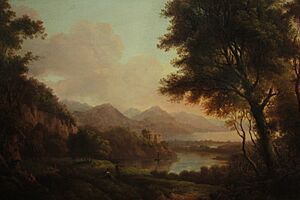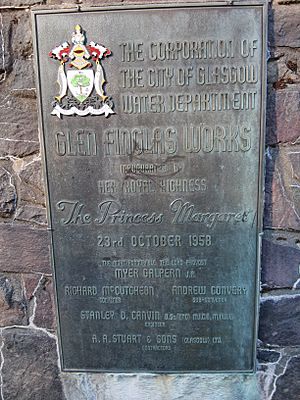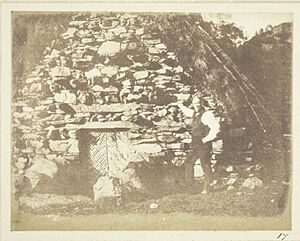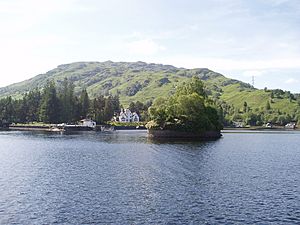Loch Katrine facts for kids
Quick facts for kids Loch KatrineLoch Ceiteirein |
|
|---|---|
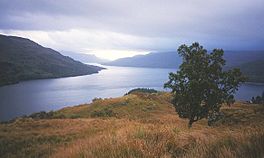
Above Stronachlachar, looking eastward along the length of the loch
|
|
| Location | Stirling area, Scotland |
| Coordinates | 56°15′16″N 4°30′56″W / 56.25444°N 4.51556°W |
| Type | freshwater loch, reservoir |
| Primary outflows | Achray Water |
| Basin countries | Scotland |
| Max. length | 13 km (8.1 mi) |
| Max. width | 1 km (0.62 mi) |
| Islands | Ellen's Isle, Factor's Isle |
Loch Katrine is a beautiful freshwater lake found in the Trossachs area of the Scottish Highlands. It's a popular spot for tourists and visitors from nearby cities like Glasgow. The loch is about 13 kilometers (8 miles) long and 1 kilometer (0.6 miles) wide at its widest point.
This famous loch is the setting for Sir Walter Scott's well-known poem, The Lady of the Lake. Later, an opera called La donna del lago by Gioachino Rossini was also based on this poem.
Contents
What's in a Name?
The name Katrine has a couple of interesting possible meanings. One idea is that it comes from an old Celtic word meaning "dark, gloomy place." This might describe the loch's shores, which were once heavily covered in forests.
Another idea is that Katrine comes from the Gaelic word ceathairne. This word could mean "cattle thief" or even "peasantry." Historically, it referred to a group of fighting men from a clan. So, it might have been used for people who raided cattle.
Loch Katrine's Important Role
Loch Katrine is now owned by Scottish Water. Since 1859, it has been the main source of drinking water for much of the city of Glasgow and the areas around it. The water level in the loch has been raised a little bit to help with this.
The water flows by gravity through a special system called the Katrine aqueduct. This system includes two long aqueducts, each about 41 kilometers (25 miles) long, and 21 kilometers (13 miles) of tunnels. The water travels to the Milngavie water treatment works. Milngavie is high enough that the water can reach most of Glasgow without needing pumps. This amazing system can deliver a huge amount of water every day!
Building this water system began in 1855. Queen Victoria herself officially opened the works in 1859. A second aqueduct was added later in 1901 to bring even more water.
To make sure there's always enough water, Loch Katrine also gets water from other places. Water comes from Loch Arklet through a dam and a short tunnel. Another longer tunnel brings water from the Glen Finglas Reservoir under Ben A'an.
The SS Sir Walter Scott
Because Loch Katrine provides drinking water, boats that use oil are not allowed on its waters. This helps keep the water clean and safe.
However, a special steamboat called the SS Sir Walter Scott has been sailing on the loch since 1900. It used to run on coal, but in 2007, it was changed to use cleaner bio-diesel fuel. This historic boat still offers fun trips for tourists between Trossachs Pier and Stronachlachar during the summer.
Places Around the Loch
The easiest ways to get to Loch Katrine are through Trossachs Pier at the eastern end or Stronachlachar at the western end. Trossachs Pier has a parking area, a pier for boats, a gift shop, and a cafe.
Along the northern shore of the loch, you can find places like Brenchoile, Letter, Edra, Strone, Coilachra, Portnellan, and Glengyle. On the southern shore, there's The Dhu, Stronachlachar, the Royal Cottage, Culligart, and Glasahoile.
It's important to know that the roads and paths don't go all the way around the loch. The road on the southern side stops at Glasahoile.
Islands of Loch Katrine
Loch Katrine has several small islands. Some of these include Ellen's Isle, which is also known as "the shingly isle," the Black Isle, and Factor's Island.
Fun Facts
- You can go fly fishing and boat fishing for trout on the loch from spring to autumn.
- There's another lake named Loch Katrine in North Canterbury, New Zealand.
- Loch Katrine is the namesake of a traditional Scottish tune called The Athole Highlanders' Farewell to Loch Katrine.
- In 1844, William Henry Fox Talbot took one of the very first photographs of the loch, which he called Scenery of Loch Katrine.
Images for kids



